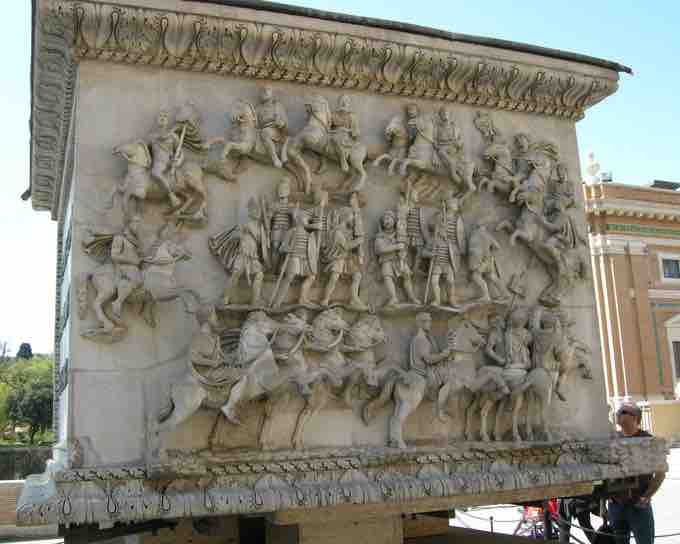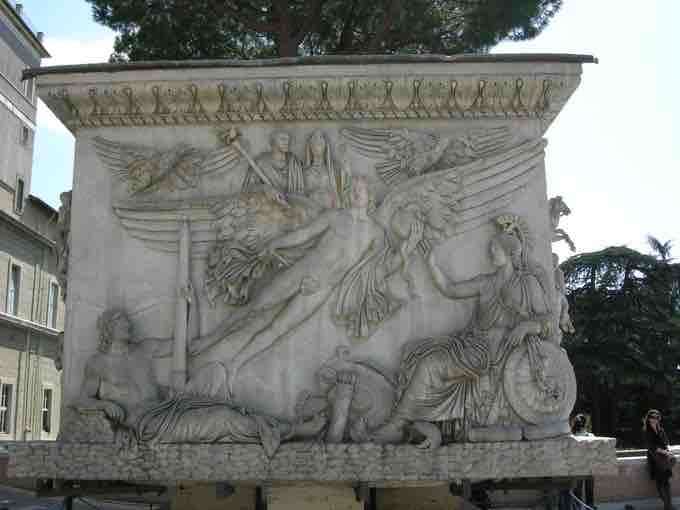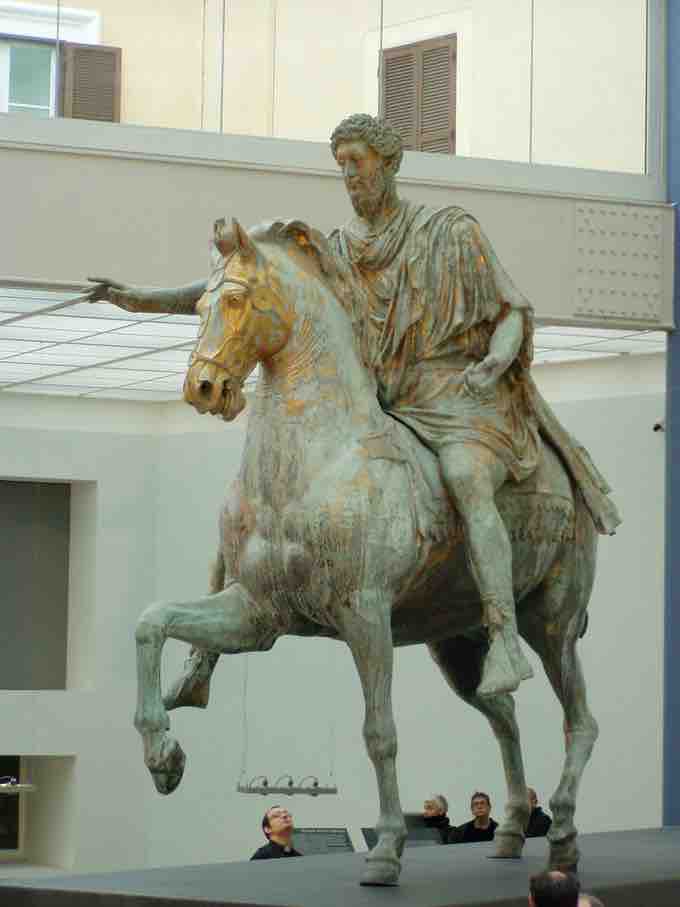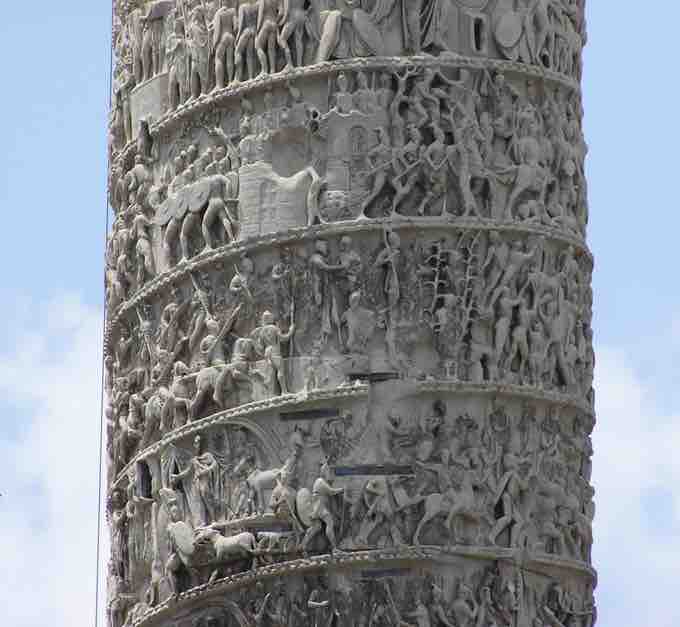Antoninus Pius
Antoninus Pius was the first of the Antonine emperors. He was adopted by Hadrian as his son and heir under the condition that he, in turn, adopt Lucius Veras and Marcus Aurelius as his sons and heirs. Antoninus accepted and established a peaceful reign, ruling from 138 to 161 CE.
Upon Hadrian's death, Antoninus persuaded the Senate to deify Hadrian, and so received the name Pius. He also deified his wife, Faustina, after her death and built a temple to her in the Republican Forum. Upon his death, Antoninus was also deified and this temple was rededicated to the both of them.
Antoninus Pius' heirs, Lucius Verus and Marcus Aurelius, had a column erected to him on the Campus Martius, the base of which survives today. On two of its sides is an identical scene of a military decursio (), depicting cavalry men parading around soldiers, two of whom hold standards. The relief carvings are noticeably deep; the figures protrude from the sides and are visible when viewing the non-decursio side of the pedestal. All naturalism has been removed from the scene. It depicts each figure from a ground-level perspective while showing the circular parade from a bird's eye view.

Decursio
Scene from the pedestal of the Column of Antoninus Pius
On one of the other two sides is a dedicatory inscription and on the panel across from that is a scene of the apotheosis of Antoninus Pius and Faustina . The scene depicts a large winged figure, Aion (Eternity), carrying them, surrounded by two eagles, to heaven. Two figures look on from the ground. One is a personification of the Campus Martius, lounging on the ground with an arm around Augustus' sun-dial obelisk, the location where the ritual of deification occurred. The other is an armed female, Roma. She wears and sits among armor, saluting the emperor and empress during their apotheosis,while leaning on a shield depicting the she-wolf suckling Romulus and Remus.

Apotheosis of Antoninus Pius and Faustina
Scene of Antoninus Pius and his wife Faustina on the pedestal of the Column of Antoninus Pius.
The style of this relief is noticeably different. While still detailed, the apotheosis scene is less deeply carved. Furthermore, the figures are more classical in form; they follow the more traditional artistic style established by Augustus. The figures on the decursio relief are stockier and in a style more commonly seen in the plebeian art of this time. These two different scenes and styles demonstrate the Classical conventions of imperial art and the emerging style developed to represent the common man.
Marcus Aurelius
Lucius Verus and his co-emperor, Marcus Aurelius, succeeded Antoninus Pius and successfully co-ruled until Lucius's death in 169. Upon the death of his adopted brother, Marcus Aurelius became the sole emperor of Rome, and his reign continued the long period of stability throughout the empire.
The Equestrian statue of Marcus Aurelius is a bronze cast that survived being melted down in the medieval period as it was fortunately mistaken to be that of Constantine, the first Christian emperor of Rome. It depicts Marcus Aurelius, large in stature, on horseback with an arm outstretched in a gesture of clemency. He wears not military garb, but is clothed simply in a toga, casting him as an emperor of peace, rather than as a military conqueror.

Equestrian Statue of Marcus Aurelius
Fortunately survived the medieval period as it was mistaken to be that of Constantine, the first Christian emperor of Rome.
A victory column was also erected for Marcus Aurelius . This is modeled on Trajan's column and was originally erected on the Campus Martius between the Temple of Divine Hadrian and the Temple of Divine Marcus Aurelius. A relief frieze encircles the column and depicts his military campaigns at the end of his life in Germania.

Column of Marcus Aurelius
Detail of five bands from the column.
Despite the similar military scenes, the artistic style of the Column of Marcus Aurelius differs greatly from the Column of Trajan. The figures in this column are stockier and their proportions are distorted. The extra-large heads and deep relief carving were utilized so that the figures were easier to see from the ground than those on Trajan's column. The military strength of the empire is emphasized more so than on the Column of Trajan where the majority of the scenes depict the preparation for battle, instead of the battles themselves. The new style, high relief, and military emphasis demonstrates the changing priorities and social-political attitudes of the period.
Commodus
Unlike the previous four emperors, Marcus Aurelius had, and so selected, his own biological son as his heir. Unlike his five predecessors, Commodus was not considered to be a good emperor and his reign generally marks the beginning of Rome's decline. Commodus was disliked by the Senate, had little interest in the administrative aspects of running a large empire, and he preferred to demonstrate physical prowess by competing in gladiatorial games.
Like Nero's public performances, Commodus' performances in the arena were considered scandalous and disgraceful. After many failed attempts, he was eventually assassinated in 192 CE.